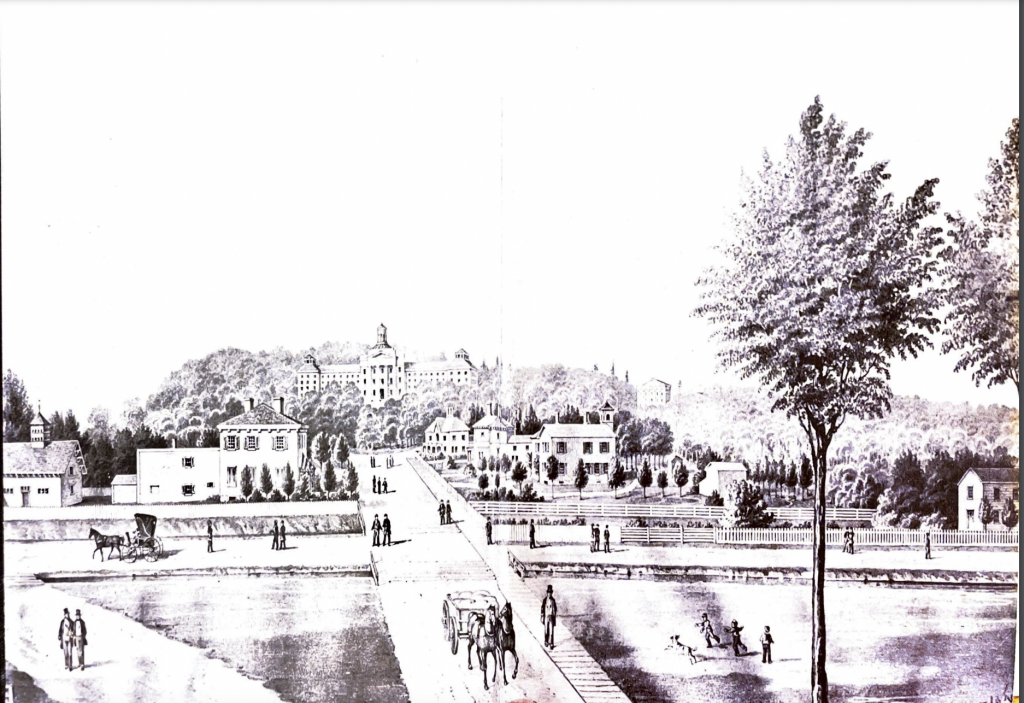Latin, Greek, Theology, Mathematics, what else could someone ask for in a liberal arts curriculum? These were the four topics that dominated the University at Lewisburg’s curriculum in its early years. While these subjects still exist today, they were once considered the cornerstone of education for a male reaching gentleman status in society.
The majority of men who attended the University at Lewisburg were educated to be lawyers, ministers, and political figures. “The percentage of men who attended college was single digits” said Karl Voss, current Dean of the College of Arts and Sciences at Bucknell University. Education was not a right of passage, but more an attempt to prove status.

As seen on the course catalog for the 1850-1851 academic year, Chemistry found its place on the very last term of senior year. However, this was not a popular extension to the curriculum for many.
“The Chemistry proposal was very controversial,” remarked Dean Voss, “there were those at the university who said ‘doesn’t Greek, Latin, and Mathematics cover it all? Why would we sully ourselves with such an applied science?’”

The only other applied science that can be seen on the first course catalog is Astronomy. Students were unable to take Astronomy until their third year. Leading up to that was all the liberal arts courses one may expect to see.
Each year seemed to include some version of Geometry. Students would take Plane Geometry, Solid and Spherical Geometry, Plane and Spherical Trigonometry, as well as Analytical Geometry. Although Engineering was not a typical study at the time, Mechanics, Hydrostatics, and Hydraulics were a requirement for third year students. Algebra was a basic math requirement each student took in their first term as a freshman.
Latin and Greek were also extremely common courses scattered around the catalog. Each student had to study different Greek and Roman writers’ works. Greek Tragedy and Greek Philosophy also played into the language and composition studies. This taught males good morals and how to act in the world.
While all the Greek and Latin courses built up the first three years, Theology and Philosophy was the main concentration during a student’s fourth year. Courses such as Intellectual Philosophy, Natural Theology, Moral Philosophy, and Butler’s Analogy stacked on top of each other and ensured students were not carried away with an application such as Chemistry. These courses acted as the send off for male students as they entered their jobs as lawyers, priests, and leaders amongst society.
Today, applied sciences like Chemistry dominate the College of Arts and Sciences at Bucknell University. With the original course subjects still standing as pillars under the institution’s current curriculum, there is no such thing as a “general studies degree” at Bucknell anymore.
Interestingly enough, the University of Lewisburg was also supposedly preparing students for careers in medicine as well. Joe Murray, a professor in the Education Department at Bucknell University, explained that this was relatively common for universities at the time. The Emergent Nation Era, which was at its peak when Bucknell University was established in 1846, allowed the higher education system to experiment with new courses to teach students.
“Bucknell had to make a decision to either stop preparing doctors or start up a medical school,” Professor Murray said. Ultimately, the decision lie within the liberal arts pillars of Bucknell, and they opted to leave behind the business.
Since Bucknell was teaching natural sciences and preparing students to become doctors, Murray assumes that meant the university was pretty far along at the time compared to others. Between this application and the establishment of a women’s institute, there is no doubt the curriculum at Bucknell was progressive from the start.

Kendy Alvarez, current mayor of Lewisburg and 2006 Bucknell graduate, studied English and minored in Sociology. She claims that today, those pillars of liberal arts courses such as Language, Philosophy, Sociology, and Political Science still stand strong as Bucknell’s foundation.
“The core liberal arts education still exists here at Bucknell and fundamentally it’s necessary,” said Mayor Alvarez. “It’s within those realms that you really tool yourself with the capacity to interact within a community.”
A major difference from the academic year in 1850 to the modern academic year at Bucknell is that there were three separate terms instead of two semesters. Students typically took three courses during each term, unlike today where students take four courses a semester.
Professor Murray revealed that college majors did not exist until the mid-20th century. Specialized education is far more common now at Bucknell, as students study the field they want to find a career in. Now, Bucknell University has three separate colleges: the College of Arts and Sciences, Freeman College of Management, and the College of Engineering. Each college was developed over the past few decades to accommodate the diversity of today’s careers.
Times have changed, but Bucknellians are still taking courses in Latin, Greek, Philosophy and Mathematics. Each student in the College of Arts and Sciences are required to take two arts and humanities courses, two second level writing courses, and a quantitative reasoning course. All students at the university must take a first-year writing course, denoted by the name “Foundation Seminar”.
It is clear that the liberal arts education still stands strong at Bucknell University. The courses that resemble similarities to those of 1850 allow students to make connections with the world and think deeper about human relations.
To read more about Bucknell University’s early curriculum, please feel free to check out the works available at Bertrand Library below in the bibliography.
Bibliography:
Bartol, William C. Development of Bucknell Athletics. Lewisburg.
Oliphant, James Orin. The Rise of Bucknell University. Appleton-Century-Crofts, 1965.
Theiss, Lewis Edwin. Centennial History of Bucknell University, 1846-1946. Grit Publishing Co. Press, 1946.

Five Minute Clip of Dean Voss on Liberal Arts Curriculum and Applied Sciences Revolution
Leave a Reply